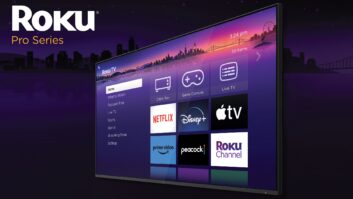
Roku Streaming Stick+
Fresh on the heels of their IPO last Thursday, Roku has unveiled an updated product line. Almost a year to the day since last year’s new product introductions, the focus is on an improved OS for both standalone devices and the growing number of Roku-equipped TVs, as well as replacement models to strengthen their segment-leading market share position.
With the introduction of a new Apple TV and Amazon Fire TV last month, Roku is looking to keep up with the pack from a features perspective and maintain its leading market share position. In addition, a major update to their operating system will soon roll out for both the standalone streaming players and the growing lineup of “Roku TV” sets from Element, Hiesnse, Hitachi, Insignia, RCA, Sharp, and TCL that is on track to encompass more than 150 individual models in North America by the end of the year.

The new Roku family of devices
The new OS 8, which will start rolling out to the streamers this month and to the Roku TV models next month, adds enhanced voice search allowing search and launch and single sign-on for TV Everywhere channels that eliminates the need for repeated login when accessing services that a user already subscribes to through AT&T, Cox, Dish, and other providers. Those capabilities match competing new models, but a redesigned “4K Spotlight Channel” goes one better by allowing search for HDR or Dolby Vision content (when allowed by the device) as well as the option to choose from multiple streaming services when a program is available from more than one source.
Beyond those universal OS 8 features, Roku TVs will add an additional range of features, including a Smart Guide that integrates off-air channels with streaming options. For OTA channels, the guide depth has been increased from seven to 14 days. The Roku Search will also extend to OTA channels as well as streaming services providing a comprehensive search base for cord-cutters.

The search feature integrates over-the-air and streaming
The voice control for the Roku TVs also will be expanded to add more TV-centric features such as an input switch and channel launch in response to the service name, e.g. “play Hulu”. Also, the private listening option will be added for OTA content, as well as streaming channels, via the Roku mobile app or, on select models, through the remote’s headphone jack.
Beyond the rollout of their OS 8 for both Roku TV products, and rolling it out as an update to many existing Roku products, the line of external streaming products will also be refreshed with an emphasis on increased processing power for faster response and channel load, improved remote features and, of course OS 8.”
The entry-level Roku Express and Express+ models both have a new processor that is said to be five times faster than first-generation models. Pricing remains at $29.99 for the broadly available Roku Express, while the Roku Express+ model, which retains composite AV ports, also remains at $39.99, available exclusively at Walmart.
The heart of the line is Roku Streaming Stick, which at $49.99, upgrades the HD-capable model to include a faster processor, voice control, and buttons for control of TV power and volume.
The new Streaming Stick+ packs a broad feature set that starts with the same 4K/UHD capability of the now discontinued Premiere and Premiere+ into a “behind the set,” rather than full-sized form factor. Along with the combination of 4K/UHD, HDR-10, and streaming up to 60fps, it also includes voice search through the app or remote as well as TV volume and power controls. Its size is slightly larger than the HD Streaming Stick, but it is still compact enough to easily fit behind a TV.
At $69.99 the Roku Streaming Stick+ has a feature set and form factor that runs right up against the new Amazon FireTV with 4K/UHD and HDR.
One unique feature of the Roku Streaming Stick+ that sets it apart from both the competition and other Roku models is an “Advanced Wireless Receiver” that is integrated with a USB cord that connects the Stick to its power supply. This is said to improve wireless performance with a four-times increase in wireless range.
With the New Roku Streaming Stick+ taking up the reins for 4K/UHD content with HDR capability at the price point of the older non-HDR 4K model, the latest version of the top-of-the-line Roku Ultra is now available at the $99.99 price point of the older Roku Premiere+. It adds the voice remote and retains the wired Ethernet port, micro SD slot, and other features from the current Roku Ultra.
Across the board, the new OS 8 upgrade and model line refresh will certainly keep Roku competitive. Preorders from retailers begin today with retail availability set for October 8.
A few additional items are worth mentioning. First, the absence of Dolby Vision on the Roku devices leaves the Chromecast Ultra and the new Apple TV 4K as the only streamers currently available with that format. However, when Dolby Vision is part of a Roku TV’s feature set, it is obviously available. Next, it is interesting to note that the pictures released for the new models all show “one-touch” access to Netflix, Sling, and Hulu, but the lower right-hand button shows a different service for each model. For example, the choice ranges from Amazon to PlayStation Vue, HBO Now, and DirecTV Now. The latter is interesting considering that Roku was one of the last to add the DirecTV app to its lineup.
Finally, the new Roku Streaming Stick+ uses the older USB mini connector on the device-side rather than the more typical USB micro-to-USB Type A. This means that any cables used with current back-of-set devices need to be replaced. In the absence of complete specs, it is difficult to say if the current requirements of the new device are greater than what is typically supplied by on-set USB ports, but experience with current models from a variety of 4K models suggest that the factory-supplied adapter will be required.
Moving into the fourth quarter’s high-volume activity, the new Roku devices, along with competitive improvements from Roku’s new OS 8, definitely tightens up the horse race for these products while giving new options to cord-cutters.







